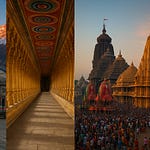Diwali, the festival of lights, is one of India’s most celebrated and spiritually charged occasions. It marks the triumph of light over darkness, knowledge over ignorance, and prosperity over scarcity. The essence of Diwali lies in invoking the blessings of Goddess Lakshmi, the divine embodiment of wealth, abundance, purity, and auspiciousness. It is believed that on this night, the Goddess roams the earth bestowing fortune upon homes that are clean, illuminated, and filled with devotion.
Across India, countless temples are dedicated to her in varied forms - as Mahalakshmi, Ashta Lakshmi, Kanaka Lakshmi, or Lakshmi Narayani. Each temple not only represents a unique expression of her grace but also carries centuries of tradition, mythological depth, and astrological importance. From ancient Shakti Peethas to modern marvels like the Golden Temple at Vellore, these sacred sites serve as beacons of divine prosperity and inner transformation.
Visiting these temples during Diwali is believed to magnify the blessings of the Goddess manifold. The vibrations on this night are said to align closely with her energies, allowing devotees to clear financial, emotional, and karmic blockages - known in astrological terms as “Dhana dosha”, “Shukra dosha”, or “Pitru dosha.” Rituals performed on this night - lighting lamps, chanting hymns, and offering sweets or gold - symbolize an inner readiness to receive divine abundance.
Below are ten of the most powerful and revered Lakshmi temples across India that devotees seek out during Diwali. Each temple has its distinct history, rituals, dosha remedies, and sacred reasons for a visit during this luminous festival.
1. Sri Lakshmi Narayani Golden Temple – Vellore, Tamil Nadu
History and Significance
Located in Sripuram near Vellore, this temple was built under the guidance of Sri Sakthi Amma in 2007. The entire structure is covered in gold, symbolizing divine prosperity. The temple is laid out in the shape of a star (Sri Chakra), guiding devotees inward toward the sanctum, representing the spiritual journey from material to divine wealth.
Why Visit
The radiance of gold during Diwali symbolizes illumination of both outer and inner life. The temple’s golden glow perfectly mirrors the spirit of the festival.
Rituals and Pujas
Daily pujas include abhishekam, alankara, archana, and evening aartis. Devotees walk the star-shaped Sri Chakra path reciting Lakshmi mantras. Fridays and full moon days are considered especially auspicious.
Doshas and Remedies
Those facing financial instability or ‘Dhana dosha’ (wealth blockages) are advised to perform milk abhishekam or offer gold or coins to the goddess here.
2. Ashtalakshmi Temple – Chennai, Tamil Nadu
History and Significance
This temple, located in Besant Nagar by the sea, honors the eight forms of Goddess Lakshmi – Aadi, Dhana, Dhanya, Gaja, Santana, Veera, Vijaya, and Vidya Lakshmi. Built in the 1970s, it represents the eightfold aspects of abundance – from wealth to wisdom.
Why Visit
It’s ideal for those seeking holistic blessings – prosperity, courage, fertility, knowledge, and victory. During Diwali, each form of Lakshmi is invoked with special lamps and chants.
Rituals and Pujas
Devotees ascend through different levels to worship each aspect. Chanting the Ashtalakshmi Stotram and lighting eight ghee lamps are essential rituals. Fridays, full moon days, and Diwali night are most powerful.
Doshas and Remedies
Performing kumkum archana helps alleviate Venus-related doshas (Shukra dosha) and enhances charm, wealth, and domestic happiness.
3. Mahalakshmi Temple – Kolhapur, Maharashtra
History and Significance
One of India’s most ancient Lakshmi temples, this shrine dates back to the 7th century and is considered one of the Shakti Peethas. It’s believed that the goddess’s eyes (Netra) fell here when Sati’s body was scattered, giving the site immense spiritual energy.
Why Visit
Visiting during Diwali or the solar event ‘Kirnotsav’ – when sunlight touches the deity’s feet – is believed to dissolve karmic debts and awaken fortune.
Rituals and Pujas
Daily rituals include abhishekam, aarti, and Lakshmi Sahasranama recitations. Navaratri and Diwali are celebrated with grand processions. Kirnotsav in January and November draws thousands.
Doshas and Remedies
People suffering from ancestral curses (Pitru dosha) or loss of wealth are advised to light sesame oil lamps and recite Kanakadhara Stotram here.
4. Mahalakshmi Temple – Mumbai, Maharashtra
History and Significance
Built in the 18th century on the shores of the Arabian Sea, this temple was constructed after the goddess appeared in a dream to an engineer struggling to build a sea wall. Her idol was later found in the sea, marking the site.
Why Visit
It’s believed that sincere worship here ensures financial stability and victory in new ventures. During Diwali, the temple glows with oil lamps, reflecting off the sea waves.
Rituals and Pujas
Fridays are most sacred. Devotees offer lotus flowers, red sarees, and gold coins. The Diwali Lakshmi Puja is performed with conch, rice, and sugar offerings.
Doshas and Remedies
Ideal for those with Saturn or Rahu-related doshas causing financial setbacks. Feeding the poor here is said to pacify these influences.
5. Lakshmi Narayan Temple (Birla Mandir) – New Delhi
History and Significance
Constructed by the Birla family in 1939, this grand temple is dedicated to Lakshmi and her consort Vishnu. It combines traditional Hindu architecture with modern elements, symbolizing the union of dharma and progress.
Why Visit
During Diwali, the temple becomes a hub of lights and devotional music. It’s ideal for those seeking harmony between material and spiritual life.
Rituals and Pujas
Morning and evening aartis, chanting of Vishnu Sahasranama, and collective Lakshmi homa are performed. Devotees light diyas in the courtyard for prosperity.
Doshas and Remedies
Performing joint worship of Lakshmi and Vishnu is said to remove marital and financial disharmony caused by Shukra–Guru imbalance.
6. Sri Kanaka Mahalakshmi Temple – Visakhapatnam, Andhra Pradesh
History and Significance
Located in Burujupeta, this temple is revered by traders and business owners. The goddess is seen as Kanaka Mahalakshmi, the golden mother who blesses sincere efforts and wealth.
Why Visit
During Diwali and Margashirsha month, the temple is adorned with gold, and offerings are made in coins and jewelry to attract prosperity.
Rituals and Pujas
Daily rituals include Ksheerabhishekam (milk bathing), Panchamrutha abhishekam, and Kumkumarchana. On Fridays, women visit in large numbers to offer turmeric and bangles.
Doshas and Remedies
Ideal for removing Dhana Sthana dosha (problems in the wealth house of the horoscope). Offer yellow cloth or chana dal to mitigate effects.
7. Sri Lakshmi Narasimha Swamy Temple – Yadadri, Telangana
History and Significance
This ancient cave temple dedicated to Lord Narasimha and Goddess Lakshmi represents divine protection and abundance. It was recently renovated with grand architectural splendor.
Why Visit
Worshipping Lakshmi alongside Narasimha is believed to remove fear, debts, and health issues while bringing prosperity.
Rituals and Pujas
Performing Narasimha Kavacha homa or Lakshmi Narasimha archana on Diwali night enhances courage and fortune. Devotees offer jaggery and ghee lamps.
Doshas and Remedies
This temple is potent for neutralizing Naga dosha and overcoming chronic obstacles caused by Mars afflictions.
8. Sri Lakshmi Narasimha Temple – Thalassery, Kerala
History and Significance
Built by the Goud Saraswat Brahmin community, this serene temple combines devotion with Kerala-style architecture. It celebrates the union of Vishnu’s fierce compassion and Lakshmi’s gentle grace.
Why Visit
Visiting during Diwali or Karthika month brings peace of mind and clears emotional disturbances.
Rituals and Pujas
Special abhishekam with coconut water and tulsi leaves is performed. Devotees light earthen lamps around the temple tank as symbolic offerings to dispel negativity.
Doshas and Remedies
Removes emotional instability and Rahu–Ketu dosha when worship is done with humility and continence.
9. Lakshmi Devi Temple – Doddagaddavalli, Karnataka
History and Significance
This 12th-century Hoysala masterpiece stands on the banks of a serene lake. Built by a merchant, it shows the link between devotion and wealth through service and architecture.
Why Visit
It is one of the few temples dedicated solely to Lakshmi from the Hoysala period. Visiting here awakens both artistic appreciation and spiritual devotion.
Rituals and Pujas
Traditional oil lamps are lit in all four sanctums. Devotees recite Lakshmi Ashtakam and offer white rice mixed with jaggery. Fridays and new moon days are highly auspicious.
Doshas and Remedies
Ideal for artists, business owners, and those with Venus afflictions. Meditating here is said to balance the creative and financial aspects of life.
10. Goravanahalli Mahalakshmi Temple – Karnataka
History and Significance
Situated near Tumkur, this temple is associated with the miraculous appearance of the goddess to a poor woman named Cheluvamma centuries ago. It is one of Karnataka’s most visited shrines.
Why Visit
Devotees believe that Mahalakshmi here grants wealth through honest means and blesses sincere hard work. Diwali celebrations include elaborate lamp-lighting and community feasts.
Rituals and Pujas
The temple conducts Mahalakshmi Homa, Kumkumarchana, and Ashtottara puja. On Fridays, special coconut and jaggery offerings are made.
Doshas and Remedies
Worship here removes financial blockages and family disharmony caused by planetary imbalances of Venus and Moon.
The Spiritual Essence
Visiting Lakshmi temples during Diwali isn’t merely a ritual of seeking money – it is a sacred act of aligning oneself with the divine principles of abundance, virtue, and gratitude. Each of these temples embodies a facet of that divine wealth – from gold and courage to wisdom and peace. With devotion, purity, and faith, the journey through these shrines can transform Diwali into a radiant celebration of both material and spiritual fulfillment.











